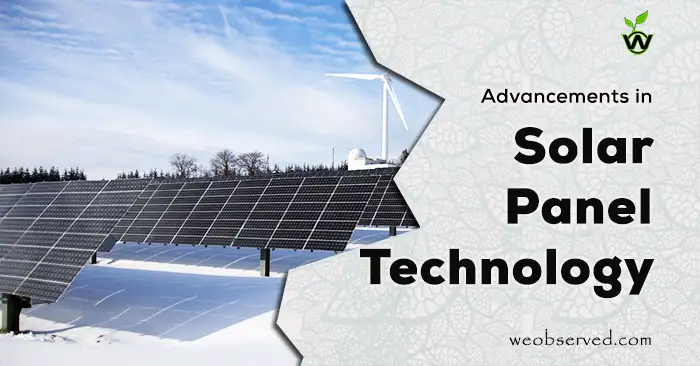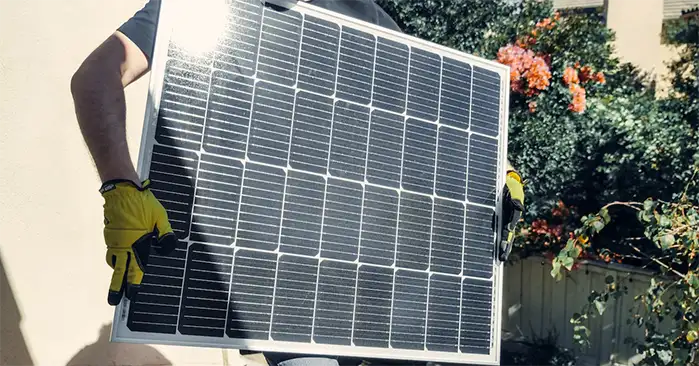Solar energy is one of the most promising renewable energy sources available today. It is clean, abundant, and sustainable, and it has the potential to revolutionize the way we generate and use electricity. In recent years, there have been significant advancements in solar panel technology that have made solar energy more efficient, affordable, and accessible than ever before. These advancements are poised to change the world in a number of ways, including:
- Reducing our reliance on fossil fuels and greenhouse gas emissions
- Creating jobs and stimulating the economy
- Improving our quality of life and making our communities more sustainable
Here are five of the most important advancements in solar panel technology that are changing the world:
5 Major Advancements in Solar Panel Technology

Solar panels are becoming more reliable as a mainstream energy source. This makes them more appealing to investors and utilities alike. Silicon solar cells are getting close to their practical limit due to some inconvenient laws of physics. Alternatives like perovskite could solve this problem. A new type of solar panel combines crystalline silicon and metal halide perovskite. This tandem gives the board higher efficiency than either technology alone. Here are 5 major Advancements in Solar Panel Technology:
1. High Power Panels
Increasing the power output of solar panel technology will allow homeowners to produce more energy from their home rooftops. This will lower their LCOE and help to offset the increase in electricity prices caused by rising fossil fuels.
Solar panel manufacturers have been developing increasingly efficient and powerful solar panels for various applications. The latest high-powered solar panels feature a maximum power point voltage of 41.5 V and an efficiency rating of up to 45%. Many manufacturers, who have broken 18 solar PV world records in efficiency and power, use tunnel oxide passivated contact technology, which reduces internal recombination losses. This increases cell efficiency and helps to improve a panel’s output in variable weather conditions.
Also Check: 38 Best Eco-Friendly Business Ideas for a Sustainable Future
Solar panels with higher efficiency ratings also offer a lower degradation rate over time. This is important as it will decrease the amount of wasted solar energy from damaged cells. This is especially important for bifacial solar panels, designed to be exposed to the elements and can lose up to 0.25% of their original rated capacity per year.
2. Perovskite Solar Photovoltaics
The world needs a lot of energy to reach net-zero carbon emissions, and solar power can play a big part. However, the cost of solar panels is a barrier to widespread adoption.
Perovskite solar cells can lower this cost. These flexible and lightweight cells produce more energy than traditional silicon-based PV modules. They also perform well in low and ambient light, making them ideal for rooftop and building-integrated photovoltaics (BIPV).
Research and development is focused on bringing these solar cells to commercialization. This involves improving the operational lifetime of the cells by addressing issues with stability and degradation. Researchers are screening materials for better performance, experimenting with alternative encapsulation and surrounding device layers, and developing approaches to mitigate degradation during fabrication and operation.
Must Read: 10 Best Kitchen Geysers in India : For Instant Hot Water
Companies are working to beat, or at least match, silicon. By layering perovskite on top of silicon, they can achieve much higher conversion efficiencies than silicon-only cells. This should reduce the levelized cost of electricity, which accounts for installation and lifetime operating costs.
3. High-Efficiency Cells

Solar panels are already incredibly effective, but scientists are always looking for ways to improve their efficiency and boost their power. Solar panel efficiency is a crucial indicator of how powerful a solar system will be. The power rating is determined based on the cell design, silicon type, multi-busbar technology, and junction and passivation (PERC). Panels with higher efficiencies have lower losses due to busbar shading and have a much more stable power output.
Solar panel efficiencies are measured under standard test conditions (STC) with a reference cell temperature of 25degC and an irradiance level of 1000W/m2. High-efficiency panels that feature N-type cells can reach efficiencies above 21%. They also have a lower rate of light-induced degradation than P-type panels and are a good option if you are worried about longevity.
4. Larger Cell Wafer Sizes
Many solar panel manufacturers are moving from the traditional 156mm square cell size to larger wafer formats like M10 or M12. These more giant cells, combined with new larger panel configurations, result in compelling solar panels with ratings of up to 700W. The larger cell size provides more surface area for absorbing sunlight and generating power. Advanced rear-side passivation technologies such as tiling ribbon and multi-busbar or TOPcon technology can boost panel efficiency by over 22%.
This has sparked a battle among major solar panel manufacturers to produce the world’s most potent panels, resulting in a flurry of innovative new panel sizes and configurations. This is good because while the solar panel industry’s efficiency gains have been substantial, they’re quickly approaching the practical limits of commercially available crystalline silicon (c-Si) solar panels.
5. Specialized Kinds of Solar Panels
As solar panel technology continues to improve, more types of solar panels are becoming available. Many are specialized for particular applications or specific climates. Some are also being studied for the potential to increase efficiency or lower costs.
Two kinds of solar panels dominate the market: monocrystalline and polycrystalline. The former is made from a single silicon crystal and generally offers the highest efficiency rates at 17% to 20%. They are also durable and long-lasting.
Also Read:Electric Vehicles are losing their purpose, Why?
Usually found on commercial buildings or homes, the latter are manufactured from melted fragments of raw silicon. They are cheaper than the mono-crystal variety but tend to have lower efficiency ratings.
Other solar panel options include cadmium-tellurium (CaT) and amorphous silicon solar cells, which are more affordable but less efficient than crystalline solar panels. Thin-film solar panels, on the other hand, use entirely new technology and are much more efficient than crystalline silicon. Still, they have the added advantage of being more lightweight and flexible. These panels are also more resistant to high temperatures but are less durable than crystalline silicon.
Advancements in Solar Panel Technology Conclusion
Solar panel technology has advanced significantly in recent years, with new materials and designs leading to more efficient and affordable solar panels.
One of the most significant advances has been the development of new materials for solar cells. Silicon is still the most common material used in solar cells, but new materials such as perovskites and organics offer the potential for higher efficiency and lower cost. Perovskites, in particular, have shown great promise in recent years, with some cells achieving efficiencies of over 20%.
Another key advance has been the development of new designs for solar panels. Traditional solar panels are made up of individual cells that are connected together in a grid pattern. However, new designs such as tandem cells and multi-junction cells can achieve higher efficiencies by using multiple layers of cells with different bandgaps.
As a result of these advances, solar panel efficiency has increased significantly in recent years. In 1954, the first commercial solar cell had an efficiency of just 4%. Today, the most efficient solar cells have efficiencies of over 25%. This means that solar panels can now generate more electricity from the same amount of sunlight, making them a more cost-effective option for renewable energy.






